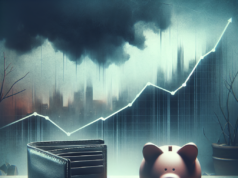
In recent months, the business world has been rocked by a startling increase in corporate bankruptcy filings, raising alarms among economists, investors, and policymakers alike. As companies across various sectors grapple with unprecedented challenges, the surge in bankruptcies has prompted a closer examination of the underlying causes and potential ramifications. This article delves into the factors driving this trend, its economic implications, notable case studies, and what the future may hold for the corporate landscape.
Understanding the Recent Surge in Corporate Bankruptcy Filings: An Overview
The recent surge in corporate bankruptcy filings marks a significant shift in the business environment, with many companies facing insurmountable financial pressures. According to data from the American Bankruptcy Institute, corporate bankruptcies have increased by over 30% in the past year alone, signaling a troubling trend that could reshape the economic landscape. This uptick is not limited to small businesses; major corporations are also succumbing to financial distress, leading to widespread speculation about the stability of the economy. The rise in filings reflects a confluence of factors, including shifts in consumer behavior, supply chain disruptions, and rising operational costs, all exacerbated by the lingering effects of the COVID-19 pandemic.
Key Factors Contributing to the Rise in Bankruptcy Among Major Corporations
Several key factors have contributed to the alarming rise in bankruptcy filings among major corporations. First and foremost, the pandemic has fundamentally altered consumer behavior, leading to a decline in demand for certain products and services. Additionally, supply chain disruptions have resulted in increased costs and delays, straining the financial health of many businesses. Inflationary pressures have further compounded these challenges, with rising prices for raw materials and labor squeezing profit margins. Moreover, the tightening of monetary policy by central banks has led to higher interest rates, making it more difficult for companies to service their debts. Together, these factors have created a perfect storm that has pushed many corporations to the brink of insolvency.
The Economic Impact of Increased Bankruptcy Filings on the Business Landscape
The surge in corporate bankruptcies is poised to have far-reaching implications for the broader economy. As companies file for bankruptcy, job losses are inevitable, leading to increased unemployment rates and reduced consumer spending. This, in turn, can create a vicious cycle, as lower consumer spending further depresses demand for goods and services, prompting additional bankruptcies. Furthermore, the wave of bankruptcies can lead to a consolidation of industries, as stronger companies acquire the assets of their weaker competitors, potentially stifling innovation and competition. The overall economic landscape may also experience increased volatility, as investors reassess risk and adjust their portfolios in response to the changing corporate environment.
Case Studies: Notable Companies That Have Filed for Bankruptcy Recently
Several high-profile companies have recently succumbed to bankruptcy, highlighting the severity of the crisis. For instance, the retail giant Bed Bath & Beyond filed for Chapter 11 bankruptcy protection, citing declining sales and mounting debt as primary factors. Similarly, the iconic toy retailer Toys “R” Us, which once dominated the market, has struggled to regain its footing and filed for bankruptcy again, unable to compete with online retailers. In the energy sector, several oil and gas companies have also filed for bankruptcy due to plummeting prices and reduced demand. These case studies serve as stark reminders of the vulnerabilities that even well-established corporations face in today’s challenging economic climate.
Legal and Financial Implications of Corporate Bankruptcy for Stakeholders
The legal and financial implications of corporate bankruptcy are profound, affecting a wide range of stakeholders, including employees, creditors, and shareholders. For employees, bankruptcy often results in job losses and uncertainty about severance packages. Creditors may face significant losses as they navigate the bankruptcy process, often receiving only a fraction of what they are owed. Shareholders, too, bear the brunt of the fallout, as the value of their investments plummets. Additionally, the bankruptcy process can be lengthy and complex, involving negotiations and court proceedings that can further complicate the financial landscape. As companies seek to restructure or liquidate, the outcomes can vary widely, leaving many stakeholders in precarious positions.
Future Outlook: What the Surge in Bankruptcy Filings Means for the Economy
Looking ahead, the surge in corporate bankruptcy filings raises critical questions about the future of the economy. While some analysts predict that the current wave of bankruptcies may lead to a necessary cleansing of the market, allowing for a more robust recovery, others warn of the potential for prolonged economic instability. The consolidation of industries may result in fewer players in the market, which could stifle competition and innovation. Moreover, if the factors contributing to the rise in bankruptcies—such as inflation and supply chain issues—persist, the economic recovery could be hampered. Policymakers will need to closely monitor these developments and consider targeted interventions to support struggling industries and promote sustainable growth.
In conclusion, the shocking surge in corporate bankruptcy filings serves as a wake-up call for businesses and policymakers alike. As the economic landscape continues to evolve, understanding the underlying causes and implications of this trend is crucial for navigating the challenges ahead. While the path to recovery may be fraught with obstacles, proactive measures and strategic planning can help mitigate the impact of these bankruptcies and pave the way for a more resilient economy in the future.




















